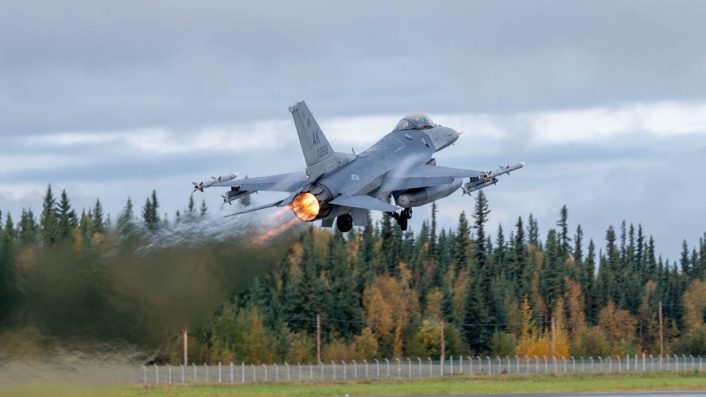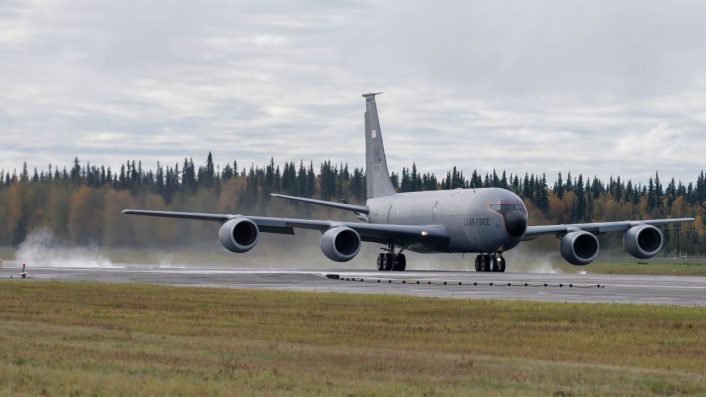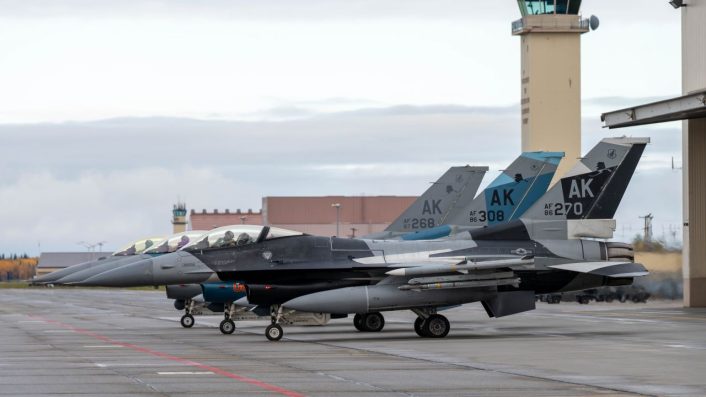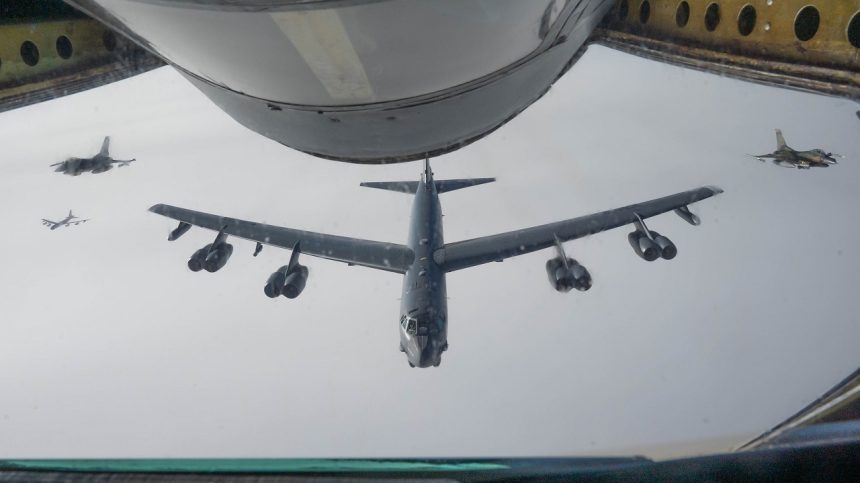Operation Polar Vortex demonstrated the ability to rapidly deploy forces to the Arctic in defense of the homelands, validating operational capabilities from strategic locations in the region and expanding multi-domain awareness.
Eielson Air Force Base, together with the NORAD (North American Aerospace Defense Command) and the U.S. STRATCOM (Strategic Command), undertook what appears to be a first-of-its-kind “Operation Polar Vortex” on Sep. 11, 2024, over the skies of Alaska.
Based on officially released images, we could count four F-16Cs from the 18th FIS (Fighter Interceptor Squadron), two B-52 Stratofortress strategic bombers, an E-3 Sentry AWACS (Airborne Warning and Control System) and two KC-135 aerial refueling tankers. The captions also indicated the presence of unspecified U.S. Navy assets.
Such an exercise, which Eielson AFB mentioned was aimed to demonstrate the ability to rapidly deploy forces to the Arctic, does not appear to have been reported before. It’s unknown if this represents some kind of response to Russia’s massive weeklong Ocean 2024 naval drills, with a considerable PLA Navy participation. Held simultaneously by the Baltic Fleet, Northern Fleet, Pacific Fleet and Caspian Sea Flotillas, the drills also appear to have a significant air component.
Recently @NORADCommand F-16 fighters escorted a @US_STRATCOM B-52 bomber across AK during Operation POLAR VORTEX to rapidly deploy forces to the Arctic in support of First Air Force and @USNorthernCmd homeland defense mission.#ALCOM #NORAD #USSTRATCOM #EIELSON #F16 #B52 pic.twitter.com/u3P11xn4RC
— Eielson Air Force Base (@EielsonAirForce) September 17, 2024
Between Sep. 11 and Sep. 15, NORAD consistently reported detecting and tracking Russian military aircraft in the Alaska ADIZ (Air-Defense Identification Zone). The command clarified that these aircraft remained in international airspace, without entering American or Canadian sovereign airspace, and were not seen as a threat, something that occurs quite regularly in the area.
On Sep. 13, NORAD detected and tracked two Russian Navy Tu-142 long-range maritime patrol and anti-submarine warfare (ASW) aircraft operating in the Alaska ADIZ. On each of the days on Sep. 14 and Sep. 15, the command also tracked two Ilyushin IL-38 ASW aircraft in the same zone.

‘Operation Polar Vortex’
Photos released on DVIDS on Sep. 11, 2024, showed a KC-135 Stratotanker taxiing to the runway before departing in support of Polar Vortex, as well as four F-16Cs from the 18th FIS (formerly the 18th Aggressor Squadron) as they conducted checks and took off from Eielson AFB. Interestingly, the KC-135 showed the “ZZ” tail flash of Kadena Air Base, Japan, which could identify it as one of the aircraft that were exchanged by Kadena’s 909th Air Refueling Squadron and the Alaska Air National Guard.
According to the captions, the F-16s “conducted integration training with the 611th Air Operations Center and Navy assets in the Alaska Theater of Operations.” The KC-135s meanwhile provided refueling support to the aircraft involved in the mission.
“The operation demonstrated First Air Force (Air Forces Northern) ability to rapidly deploy forces to the Arctic and execute a range of capabilities and response options to deter, disrupt, degrade and deny competitor activity in support of U.S. Northern Command and integrated, layered defense of the Homeland,” said the captions. “Deterring and protecting the homelands from aggression requires the persistent and seamless exchange of information with combatant commands, conventional and special operations forces, the intelligence community, and the spectrum of interagency and international partners.”

Notably, the photos of Operation Polar Vortex released by Eielson AFB show the F-16s carrying live AIM-120 AMRAAM and AIM-9 Sidewinder missiles, as well as two external fuel tanks and targeting pods, the standard configuration employed during Quick Reaction Alert (QRA) missions. It’s unknown if the B-52s were also equipped with live weapons and if they employed any on the Alaskan training ranges.
The 18th Fighter Interceptor Squadron’s F-16s
The 18th Aggressor Squadron, to which the F-16s involved in Operation Polar Vortex are assigned, was the dedicated Aggressor unit in Alaska that was redesignated as 18th Fighter Interceptor Squadron on Feb. 2, 2024. The redesignation underscored the unit’s renewed focus on air defense, which has been ongoing for a while as the 18th AGRS complemented the F-22 in this role with a number of F-16 on QRA duties since late 2022.
One of its F-16s, sporting the Aggressors’ blue splinter camouflage scheme, was involved in the interception of four Russian military aircraft on May 2. These comprised Tu-95MS strategic bombers and Su-35S and Su-30SM multirole fighters in an 11-hour mission that flew inside Alaska’s ADIZ and were tracked by NORAD.
The unit has been receiving upgraded F-16s Block 30 from the Air National Guard throughout 2023. It appears that the unit will continue to employ, at least for the time being, both standard livery and Aggressor livery F-16s, with the former dedicated to the homeland defense mission and the latter mainly dedicated to the adversary role.

The F-16s received from the ANG feature upgrades comparable to the PoBIT upgrades currently being performed on the Block 40 and Block 50 fleets. Two of the major upgrades are the APG-83 Active Electronically Scanned Array (AESA) radar, fielded in 2020, and the Center Display Unit, a 6 by 8 inches multi-function high resolution color display which replaced the instruments located on the center pedestal in 2013.
Russian Ocean 2024 drills and Chinese participation
The Russian Navy is appearing to wrap up its weeklong exercise Ocean 2024. It involves more than 400 warships, submarines and support vessels, more than 120 naval aircraft and more than 90,000 personnel from the Russian Navy’s Northern, Baltic and Pacific Fleets and the Caspian Sea Flotilla. The exercise takes place in the waters of the Pacific and Arctic oceans and the Mediterranean, Caspian and Baltic seas.
A selection of footage from the strategic command and staff exercise “Ocean-2024,” conducted by units of the Pacific Fleet, Black Sea Fleet, Northern Fleet, Baltic Fleet, and the Caspian Flotilla of the Russian Navy. pic.twitter.com/VaLfx7oHWU
— Venik (@venik44) September 15, 2024
However, according to USNI, the Russian Ministry of Defence (RuMoD) press releases made no mention of Tu-142 and IL-38 conducting drills in the Bering Sea area, covered by the Alaska ADIZ, as part of the exercise. The RuMoD only mentioned the two types of aircraft taking part in the exercise conducting anti-submarine warfare drills in the Sea of Japan.
🇺🇸🇷🇺 BIG MOVES IN THE PACIFIC: US Army’s 11th Airborne Division & Task Forces hit Alaska’s Shemya Island, packing M142 HIMARS & Q-53 Radars for power play. Meanwhile, Russia’s Navy lands troops on Chukotka during massive “Ocean-2024” drills! pic.twitter.com/UxzwpG7aqT
— Militant Tracker (@MilitantTracker) September 16, 2024
USNI quoted a Sep. 19 RuMoD (Russia Ministry of Defense) statement that identified China’s PLA Navy’s cruiser CNS Wuxi, destroyer CNS Xining, frigate CNS Linyi and fleet oiler CNS Taihu to participate in Ocean 2024. These conducted maneuvers with Russian Navy corvettes Sorvershenny, Gromky, Hero of the Russian Federation Aldar Tsydenzhapov and other Russian ships. The flotilla formed a “joint Russian-Chinese ship battle force that drilled together in the Sea of Japan,” according to the release.
The maneuvers comprised anti-aircraft, anti-submarine, and anti-mine defense drills in the central part of the Sea of Japan where, under a joint command, the ships repelled an attack of the mock air enemy with artillery live fires, crossed a mine-hazardous area and destroyed a buoyant mine. “Russian and Chinese sailors also trained to fight against high-speed uncrewed surface vehicles and unmanned aerial vehicles, as well as performed live fires at night to hit a naval target,” read the release.
Prior to that, on Sep. 13, the RuMoD said the two sides carried out live fires of guns and missiles in the Sea of Japan, with Russia sending 15 warships, including cruiser Varyag, destroyers Marshal Shaposhnikov, Admiral Panteleyev, corvettes Sorvershenny, Hero of the Russian Federation Aldar Tsydenzhapov, Rezkiy, two diesel submarines, as well as 10 Russian Air Force naval aircraft.









